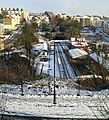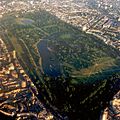Decimus Burton facts for kids
Quick facts for kids
Decimus Burton
|
|
|---|---|
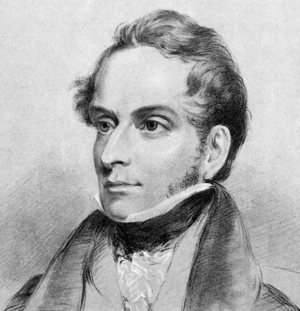
Burton by Sir Thomas Lawrence
|
|
| Born | 30 September 1800 North House, Southampton Terrace, Bloomsbury, London, England
|
| Died | 14 December 1881 (aged 81) 1 Gloucester Road, Kensington, London, England
|
| Resting place | Kensal Green Cemetery, London |
| Education | Tonbridge School |
| Alma mater |
|
| Occupation | Architect |
|
Notable work
|
|
| Parents |
|
| Relatives |
|
Decimus Burton FRS FRSA FSA FRIBA (born September 30, 1800 – died December 14, 1881) was a very important English architect and landscape designer in the 1800s. He was known for his work in the Roman, Greek, Georgian neoclassical, and Regency styles. He helped start the Royal Institute of British Architects and was an architect for the Royal Botanic Society. He also designed the famous Athenaeum Club, London, which his father's company built.
Burton designed many famous places in London, like parts of Hyde Park, London (including the Wellington Arch and gates), Green Park, and St James's Park. He also worked on Regent's Park, designing beautiful buildings like Cornwall Terrace and The Holme. He designed the Palm House and Temperate House at Kew Gardens. Beyond London, Burton helped design seaside towns like St Leonards-on-Sea, Fleetwood, and Folkestone, and also Royal Tunbridge Wells.
Burton was part of London high society during the Georgian era and Regency era. He was friends with important people like Princess Victoria (who later became Queen) and the Duchess of Kent. His family home, The Holme in Regent's Park, was designed by him and built by his father.
Contents
Family Life
Decimus was the tenth child of James Burton, a very successful property developer in London. His mother was Elizabeth Westley. His father changed their family name from Haliburton to Burton in 1794.
Decimus had several siblings, including James Burton, who was an Egyptologist (someone who studies ancient Egypt), and Henry Burton, who was a doctor.
Learning to be an Architect
Decimus grew up in North House in London and later at Mabledon House in Kent. He started learning about architecture from his father, who was also a talented builder and designer. He also took drawing lessons from George Maddox.
In 1816, Decimus left Tonbridge School and joined the Royal Academy Schools in 1817. There, he was taught by Sir John Soane, a famous architect. Soane taught him about the Neo-Palladian style, which was a type of classical architecture.
Working with John Nash
Decimus also learned from John Nash, another well-known architect. Nash worked closely with Decimus's father, James Burton, who helped fund many of Nash's projects. Nash saw Decimus's talent and helped him get important design jobs.
In 1821, Nash asked Decimus to design Cornwall Terrace in Regent's Park. Decimus also designed Grove House in Regent's Park. Later, he designed Clarence Terrace and other buildings in Regent's Park, including his family's home, The Holme. Decimus often followed his own ideas, even if they differed from Nash's. He became a leading architect for projects like Carlton House Terrace.
Other Interests
Decimus was very smart and interested in many subjects, including art and science. He had a huge library filled with books on different topics, from history to classical architecture. He traveled a lot in Europe and North America, visiting places like France, Spain, Italy, Canada, and the United States. These travels helped him get new ideas for his designs.
Burton was a master of Greek revival architecture, but he was also inspired by Ancient Roman architecture. His Georgian neoclassical buildings are considered some of his best work. Later in his career, he also designed buildings in the Gothic revival style, though he wasn't as passionate about it.
Life and Personality
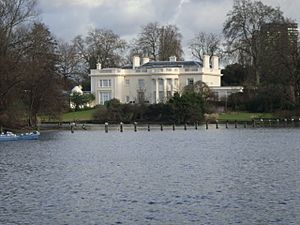
Decimus Burton was known for being wealthy, well-dressed, and polite. He was a key member of the Athenaeum Club, London, a famous club where he met many important people. People admired his honesty and skill. He was treated more like a friend than just an architect by the rich and powerful.
His friends included Princess Victoria, the Duchess of Kent, and the Duke of Devonshire. Decimus and his family often hosted their Canadian cousin, Thomas Chandler Haliburton, when he visited London.
From 1818, Burton lived with his father at The Holme in Regent's Park. This house was designed by Decimus himself and was considered one of the most desirable private homes in London. It was one of the first villas built in Regent's Park.
Burton also had offices and homes in Spring Gardens in London and Tunbridge Wells. He was very successful and earned a lot of money.
He retired in 1869 and lived in Kensington and St. Leonards-on-Sea. He never married or had children. He passed away in December 1881 and was buried in Kensal Green Cemetery. He donated many of his plaster casts (models of sculptures) to the Victoria and Albert Museum.
Major Projects
London Parks
In the 1820s, the King and government decided to improve Hyde Park, London and the surrounding areas to make London look grander. Decimus Burton was chosen as the architect for this big project. He wanted to create a space that celebrated the royal family and national heroes.
He designed new gates and lodges for Hyde Park, including Cumberland Gate, Stanhope Gate, Grosvenor Gate, and the Hyde Park Gate/Screen. His designs for these buildings, which needed windows and chimneys in a classical style, were highly praised.
At Hyde Park Corner, the King wanted a grand entrance to Buckingham Palace. Burton designed a beautiful gateway and a triumphal arch, which is now the Wellington Arch. This arch was meant to be a grand entrance for people approaching the palace.
The Wellington Arch Statue
The Wellington Arch was supposed to have a small statue on top, but a very large equestrian (horseback) statue of the Duke of Wellington was placed there instead. Decimus Burton strongly disagreed with this, saying it was too big and would "disfigure" his arch. He felt it would make his beautiful design look like just a pedestal.
Many people, including other architects and London residents, agreed with Burton. They thought the statue was out of proportion and should be moved. Even the Prime Minister thought another site would be better. However, the statue was still placed on the arch in 1846. People continued to criticize it, and eventually, in 1883, the large statue was moved to Aldershot. A different, more fitting statue was then placed on the arch.
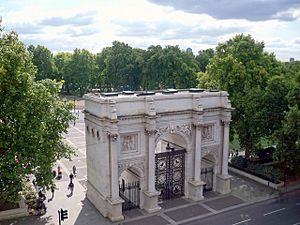
In 1847, Marble Arch, which was originally at the entrance to Buckingham Palace, was moved to the northeast corner of Hyde Park. Decimus Burton helped with this relocation and also advised on redesigning the forecourt of Buckingham Palace, creating the courtyard we see today. Moving the arch, stone by stone, was a huge engineering task that took four years.
London Zoo
By 1829, Burton had finished designing the London Zoo, which opened in 1828. His work received great praise. People loved his zoo buildings because they were fun and beautiful, making a visit to the zoo an enjoyable experience. Burton designed the zoo in a "picturesque" style, with early animal houses looking like charming cottages.
Architecture and Environment
Burton was one of the first architects to think about how buildings affect the overall look and feel of a city. He believed that urban spaces could have national and political importance.
Athenaeum Club
The Athenaeum Club was started in 1824 for people interested in literature, science, and the arts. Decimus Burton, who was only 24 at the time, was chosen to design their permanent clubhouse.
Burton's design for the Athenaeum clubhouse is in the Neoclassical style, combining elements from ancient Greek, Roman, and Italian Renaissance architecture. It has a grand entrance with columns and a central staircase. The club members were very happy with his work, praising his skill and the beauty of his designs. Decimus became a very important member of the club.
Calverley Estate
Burton was hired to develop the Calverley Estate in Royal Tunbridge Wells. He designed villas (large houses) for wealthy families, each with space for servants. His designs mixed Georgian neoclassical style with Italianate, Old English, Tudor, and Gothic elements.
He also designed a crescent of shops and three grand entrances to the estate. His work at Calverley Estate was highly praised and called "a landmark in English domestic architecture" and a "prototype garden suburb." It's considered one of the great architectural successes of the 1800s.
Glasshouses

Decimus Burton was a key designer for the 'Great Stove' (a large conservatory) at Chatsworth House. He also designed the 'Winter Garden' glasshouse for the Royal Botanic Society in Regent's Park.
His most famous glasshouse designs are the Palm House and the Temperate House at Kew Gardens. The Palm House was a collaboration with Richard Turner, combining Burton's elegant designs with Turner's metalwork skills. It's considered a very bold and important 19th-century building.
The Temperate House at Kew, which is twice the size of the Palm House, is the world's largest surviving Victorian glass structure. It was finished after Burton's death and is now one of his most admired works. Burton's glasshouses at Kew helped the gardens become a UNESCO World Heritage Site in 2002.
Other Achievements
From 1830 to 1834, Burton studied at Clifford's Inn, and he is believed to have designed some of its buildings.
In 1832, Decimus Burton became a Fellow of the Royal Society, which is a very high honor for scientists and thinkers. He was also a Fellow of the Royal Society of Arts and the Society of Antiquaries of London. He was a founding member and vice-president of the Royal Institute of British Architects.
Students and Legacy
Burton taught several architects, including his nephew, Henry Marley Burton, who took over his practice after Decimus retired.
Even though some of his papers and library were sold after his death, Decimus Burton's buildings in London, especially around Hyde Park, Green Park, and Regent's Park, are a lasting reminder of his talent. His reputation has grown over time, and societies have been formed to protect his work.
His use of iron and glass in buildings like the Palm House at Kew is now seen as an early example of Modernism. His work continues to be celebrated in places like Phoenix Park in Dublin, which he also helped design.
List of Architectural Projects
Here are some of the many projects Decimus Burton worked on:
Buckinghamshire
- Stockgrove House, Buckinghamshire/Bedfordshire border (1831) – no longer standing.
Derbyshire
- The Great Conservatory and the Home Farm at Chatsworth (1836–1840) – the Conservatory was taken down around 1920.
-
Great Conservatory, Chatsworth House, with Joseph Paxton
Dorset
- Lower Pleasure Gardens, Bournemouth (1840s)
- St Mary's Church, Bradford Peverell (1850)
East Sussex
- Oaklands Park, Sedlescombe (1830)
- Adelaide Crescent, Hove, Brighton (1831–1834) – only the first 10 houses were built to Burton's original design.
- Wick Hall, Hove (1840) – no longer standing.
- Furze Hill Villa, Brighton (1833)
- Holy Trinity Church, Eastbourne (1837-1839)
- St Augustine's Church, Flimwell (1839)
- Worth Park, Sussex (additions, 1833)
St Leonards-on-Sea
In 1828, Decimus's father, James, bought land in East Sussex to build a new town called St Leonard's-on-Sea. Decimus designed most of the buildings there.
-
Warrior Square Station, St Leonard's-on-Sea
Central London
- The Holme, Inner Circle, Regent's Park (1818) – his family's mansion.
- Clarence Terrace, Regent's Park (1823)
- The original Winfield House (1825) – later rebuilt.
- Cornwall Terrace, Regent's Park (1821)
- Chester Terrace, Regent's Park
- York Terrace, Regent's Park
- Hyde Park Screen (1824)
- Hyde Park, London: Stanhope, Grosvenor, and Cumberland Gates and their lodges.
- Spring Gardens, St. James's Park, No. 10, 12, and 14 (1827) – his townhouse and office.
- Wellington Arch, Hyde Park Corner (1827)
- Athenaeum Club, London Clubhouse (1827–1830)
- 3 and 4 Carlton House Terrace (1828)
- Charing Cross Hospital (1830)
- Clifford's Inn (1830)
- Temple Church, London (restoration, with Sydney Smirke) (1841–1843)
- Devonshire House, Piccadilly (additions: portico, hall, staircase) (1843)
- Grove House (later 'Nuffield Lodge') Regent's Park
- London Colosseum, Regent's Park (1823–1827) – no longer standing.
- Zoological Society of London Gardens (1826–1841)
- London Zoo, various buildings (1826–1828) and (1831–1834) – some still exist, like the Giraffe House and the tunnel.
- Kew Gardens: Layout of gardens and paths, Palm House (1844–1848), Main Gate (1846, now The Elizabeth Gate), Water Lily House (1852), The Museum (1857), Temperate House (1859–1863).
- Beulah Spa, Upper Norwood, London (1831) – he designed the grounds and buildings for this popular resort.
- Holwood House, Keston (1823–1826) – described as "splendidly Grecian."
- Lodges and Gates at Chiswick House (1835).
-
Inner Circle, Regent's Park, 1833 Schmollinger map
-
St. John's Lodge, Regent's Park
-
London Zoo c.1854
-
Hyde Park and part of Kensington Gardens c.1833
-
Aerial view of Hyde Park
-
Wellington Arch, Hyde Park Corner
-
Green Park, London, and Constitution Hill
-
St James's Park Lake, to the northwest, and Buckingham Palace
-
Green Park and St. James's Park c.1833
-
Charing Cross Hospital, Villiers Street London, c. 1902
-
Elizabeth Gate, Kew Gardens
-
The Temperate House, Kew Gardens
-
Kew Gardens Water Lily House
-
Holwood House, Keston
Hampshire
- Bay House (originally Ashburton House), Gosport (1838)
Hertfordshire
- Haydon Hill House, Bushey (1840s) – now converted into flats.
Kent
- Calverley Estate, Royal Tunbridge Wells (started 1828)
- Holy Trinity Church, Tunbridge Wells (1827–1829)
- Calverley Park Crescent, Tunbridge Wells (c.1833)
- Burrswood Hospital, Tunbridge Wells (1830s)
- St. Peter's Church, Southborough, Kent (1830)
- Bentham Hill House, Southborough, Kent (1830–1833) – now converted into flats.
- St. Mary's Church, Riverhead, Kent (1831)
- Culverden House, Tunbridge Wells, Kent (1830) – no longer standing.
- East Cliffe House (additions), Ramsgate, Kent.
-
Calverley House, c. 1860, Royal Tunbridge Wells
-
Calverley Park Crescent Royal Tunbridge Wells
-
Tunbridge Wells, Victoria Lodge
-
St Peter's Church, Southborough, Kent
-
Great Culverden Park Lake
Lancashire
Decimus was asked to design the new port and seaside resort of Fleetwood after his successful work at St Leonards-on-Sea.
- The Beach Lighthouse, Fleetwood (1839–1840)
- St Peter's Church, Fleetwood (1839–1841)
- Pharos Lighthouse, Fleetwood (1840)
- North Euston Hotel, Fleetwood (1841–1842)
- Queens Terrace Gardens, Queen's Terrace, Fleetwood
- The Customs House, now the Fleetwood Museum
Norfolk
- Sennowe Hall, near Guist (extended 1855–1856) – very little of Burton's work remains.
North Yorkshire
- Grimston Park, near Tadcaster (1839–1840)
Nottinghamshire
- The Grammar School, Retford (1855–1857)
-
Burton's King Edward VI Grammar School, Retford
West Sussex
- St Mary's Church, Goring-by-Sea (1836–1838) – Burton redesigned this church.
Ireland
Burton spent twenty years working on Phoenix Park in Dublin, making it more modern and beautiful. He designed paths, moved monuments, and built gates.
- Lay-out and gates, Dublin Zoo, Royal Irish Constabulary headquarters in Phoenix Park, Dublin (1840)
- Queenstown, County Cork (1840s) – he was invited to improve this seaside resort.
- Martinstown House, County Kildare (1833)
-
Phoenix Monument, Phoenix Park, Dublin
-
Dublin - Phoenix Park Jaunting car Postcard, c. 1905
-
Phoenix Park - Wellington Monument
-
Garda (Police) HQ in Dublin's Phoenix Park
-
Dublin Zoo entrance lodge (1833)
-
Queenstown, aka Cobh, c. 1890
-
Cobh dominates Cork Harbour
Images for kids
See also
- Richard Turner










